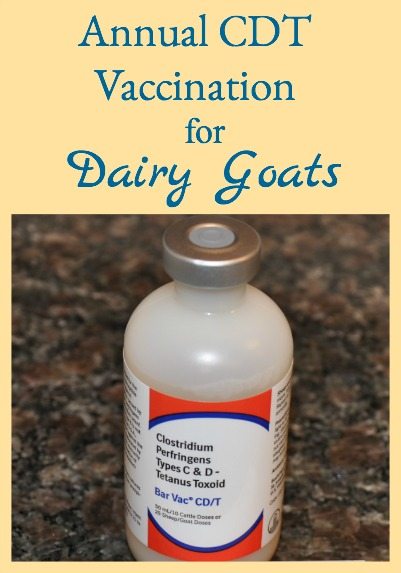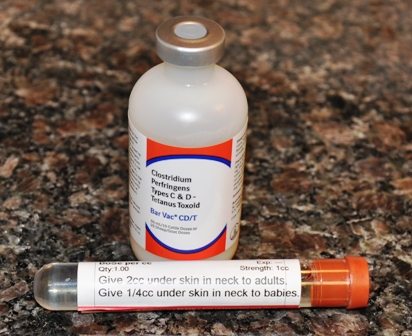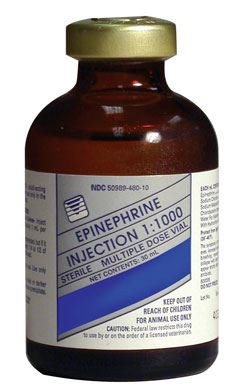A 
Why An Annual Goat CDT Vaccination Is Necessary
Clostridial bacteria are found in the soil, and clostridial diseases can cause sudden death. CDT vaccines protect goats from these diseases.
Two vaccines are commonly used for goats, a 3-way vaccine called CDT and an 8-way vaccine called Covexine-8. The 3-way vaccine protects goats from clostridium perfringins type C and D (overeating disease) and clostridium tetani (tetanus). The 8-way vaccine protects goats against additional forms of clostridium, but the 3-way vaccine is usually sufficient for dairy goats in the US.
The tetanus toxoid in the 3-way vaccine provides long-term protection from tetanus (deadly if untreated) which is caused when a wound becomes infected with tetanus bacteria.
Enterotoxemia is a condition where the clostridium bacteria normally present in a goat’s intestinal tract grow uncontrollably. This occurs when the movement of food through the intestines slows because of overeating of grain, spring pasture, milk, or milk replacer. It often occurs after goats eat too much spring growth. Therefore it is commonly referred to as “overeating” disease (also deadly if untreated).
When To Vaccinate Goats With CDT
Does, bucks and wethers should receive CDT shots annually, and it’s common for breeders to give pregnant does their annual shot about a month before they’re due to freshen. This passes immunity to the kids when they drink the colostrum (see Newborn Goat Kids Need Colostrum) of the dam.
The kids’ immunity will begin to decline at about six weeks, so it’s common for breeders to give kids their first CDT vaccine at six to eight weeks. This is followed by a booster three to four weeks later. If kids are from a dam that has not been vaccinated, they can be vaccinated at three to four weeks, and also need the booster three to four weeks later.

CDT Vaccine
Vaccinating kids born to unvaccinated dams earlier may not be effective due to their immature immune systems. If kids from unvaccinated dams are going to be disbudded or castrated before immunity can be established, then the tetanus antitoxin should be used to provide temporary, short-term protection from tetanus. They will still need to be vaccinated with the CDT toxoid at three to four weeks, and again in three to four weeks to establish long-term protection for all three diseases.
How To Give CDT Vaccinations To Goats
CDT injections are given subcutaneously (SQ or subQ) under the skin. A needle length of about 1”, gauge of 18 to 20, and the “tent” method is used. The loose skin is pulled up in the area of the injection site. The syringe and needle are held parallel to the body and the needle is pushed through the skin to administer the vaccine into the cavity created.
The dosage for CDT is 2ml for adults or kids. It’s not uncommon for an abscess to develop at a CDT injection site. Therefore, the armpit (region behind the base of the front legs) is often the preferred site for CDT vaccinations. Always use a new needle to vaccinate each goat to prevent disease. CDT vaccines should be stored in the refrigerator.

Epinephrine
One thing to always have on hand when giving goats injections is epinephrine. It can save a goat if it goes into anaphylactic shock from an injection. The dosage is 1 cc per 100 lbs.
Epinephrine is an Rx drug and is one of the few drugs that are not good beyond its expiration date. So, a new bottle is necessary every year (store it in the refrigerator). If a goat does go into shock, there’s no time to go get the epinephrine. Always have it on hand with a fresh needle and syringe when giving goats injections.
KatrinaAnon says
I am seeing that some people are recommending boosters 1 month after initial vaccination for adult and juvenile goats. What is the truth?
Debbie says
Is it too late to give cry to pregnant mom who is about 2 weeks from giving birth?
Thank you for all the great information also.
Habe a blessed day !
Lesa says
Hi Debbie, the idea for giving the CDT to the dams about a month before is so that they can establish immunity that they then pass on to the kids through the colostrum. I don’t think it should hurt anything to give it to her a little late, it’s just a question of whether she’ll have time to develop and pass on her immunity. Maybe it would be good to just go ahead and vaccinate the kids at about 4 weeks and then again 4 weeks later in addition to giving mom hers now.
Lynne Lilley says
I have chickens (6 n) n goats n the info on wethering and shots was very helpful. Had goats bout 4 months n Ms. Clara was not supposed to be pregnant!! Anywho. I have 2 adorable grandkids but I need to band the boys. Thanks for info. Lynne